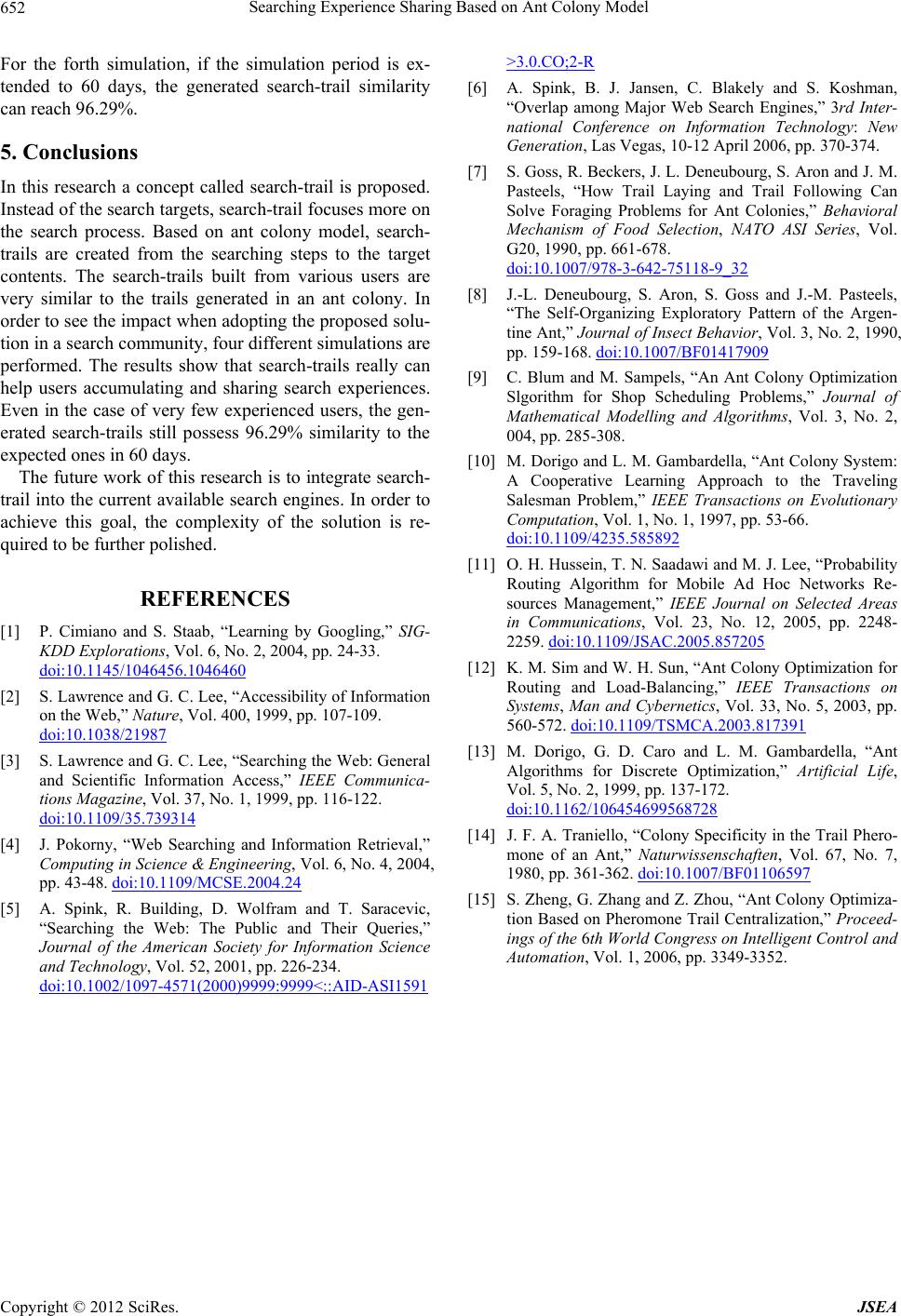
Searching Experience Sharing Based on Ant Colony Model
Copyright © 2012 SciRes. JSEA
652
For the forth simulation, if the simulation period is ex-
tended to 60 days, the generated search-trail similarity
can reach 96.29%.
5. Conclusions
In this research a concept called search-trail is proposed.
Instead of the search targets, search-trail focuses more on
the search process. Based on ant colony model, search-
trails are created from the searching steps to the target
contents. The search-trails built from various users are
very similar to the trails generated in an ant colony. In
order to see the impact when adopting the proposed solu-
tion in a search community, four different simulations are
performed. The results show that search-trails really can
help users accumulating and sharing search experiences.
Even in the case of very few experienced users, the gen-
erated search-trails still possess 96.29% similarity to the
expected ones in 60 days.
The future work of this research is to integrate search-
trail into the curren t available search engines. In order to
achieve this goal, the complexity of the solution is re-
quired to be further polished.
REFERENCES
[1] P. Cimiano and S. Staab, “Learning by Googling,” SIG-
KDD Explorations, Vol. 6, No. 2, 2004, pp. 24-33.
doi:10.1145/1046456.1046460
[2] S. Lawrence and G. C. Lee, “Accessibility of Information
on the Web,” Nature, Vol. 400, 1999, pp. 107-109.
doi:10.1038/21987
[3] S. Lawrence and G. C. Lee, “Searching the Web: General
and Scientific Information Access,” IEEE Communica-
tions Magazine, Vol. 37, No. 1, 1999, pp. 116-122.
doi:10.1109/35.739314
[4] J. Pokorny, “Web Searching and Information Retrieval,”
Computing in Science & Engineering, Vol. 6, No. 4, 2004,
pp. 43-48. doi:10.1109/MCSE.2004.24
[5] A. Spink, R. Building, D. Wolfram and T. Saracevic,
“Searching the Web: The Public and Their Queries,”
Journal of the American Society for Information Science
and Technology, Vol. 52, 2001, pp. 226-234.
doi:10.1002/1097-4571(2000)9999:9999<::AID-ASI1591
>3.0.CO;2-R
[6] A. Spink, B. J. Jansen, C. Blakely and S. Koshman,
“Overlap among Major Web Search Engines,” 3rd Inter-
national Conference on Information Technology: New
Generation, Las Vegas, 10-12 April 2006, pp. 370-374.
[7] S. Goss, R. Beckers, J. L. Deneubourg, S. Aron and J. M.
Pasteels, “How Trail Laying and Trail Following Can
Solve Foraging Problems for Ant Colonies,” Behavioral
Mechanism of Food Selection, NATO ASI Series, Vol.
G20, 1990, pp. 661-678.
doi:10.1007/978-3-642-75118-9_32
[8] J.-L. Deneubourg, S. Aron, S. Goss and J.-M. Pasteels,
“The Self-Organizing Exploratory Pattern of the Argen-
tine Ant,” Journal of Insect Behavior, Vol. 3, No. 2, 1990,
pp. 159-168. doi:10.1007/BF01417909
[9] C. Blum and M. Sampels, “An Ant Colony Optimization
Slgorithm for Shop Scheduling Problems,” Journal of
Mathematical Modelling and Algorithms, Vol. 3, No. 2,
004, pp. 285-308.
[10] M. Dorigo and L. M. Gambardella, “Ant Colony System:
A Cooperative Learning Approach to the Traveling
Salesman Problem,” IEEE Transactions on Evolutionary
Computation, Vol. 1, No. 1, 1997, pp. 53-66.
doi:10.1109/4235.585892
[11] O. H. Hussein, T. N. Saadawi and M. J. Lee, “Probability
Routing Algorithm for Mobile Ad Hoc Networks Re-
sources Management,” IEEE Journal on Selected Areas
in Communications, Vol. 23, No. 12, 2005, pp. 2248-
2259. doi:10.1109/JSAC.2005.857205
[12] K. M. Sim and W. H. Sun, “Ant Colony Optimization for
Routing and Load-Balancing,” IEEE Transactions on
Systems, Man and Cybernetics, Vol. 33, No. 5, 2003, pp.
560-572. doi:10.1109/TSMCA.2003.817391
[13] M. Dorigo, G. D. Caro and L. M. Gambardella, “Ant
Algorithms for Discrete Optimization,” Artificial Life,
Vol. 5, No. 2, 1999, pp. 137-172.
doi:10.1162/106454699568728
[14] J. F. A. Traniello, “Colony Specificity in the Trail Phero-
mone of an Ant,” Naturwissenschaften, Vol. 67, No. 7,
1980, pp. 361-362. doi:10.1007/BF01106597
[15] S. Zheng, G. Zhang and Z. Zhou, “Ant Colony Optimiza-
tion Based on Pheromone Trail Centralization,” Proceed-
ings of the 6th World Congress on Intelligent Control and
Automation, Vol. 1, 2006, pp. 3349-3352.